Recently, the Maplewood Division of Arts & Culture Manager Sally Unsworth sat down with local artists Sandra Charlap and Jocelyn Fine to discuss their upcoming exhibition at 1978 Arts Center entitled “Beyond Friends: The Places We Paint,” which was chosen by the township to celebrate Women’s History Month. The show opens on March 10, 2023, from 6-9 p.m. at 1978 Springfield Avenue in Maplewood, NJ. On March 20, Maplewood Township Committee member Nancy Adams will moderate an Artist Talk from 7-9 PM with the artists.
The interview is posted here with permission of the Maplewood Division of Arts and Culture.
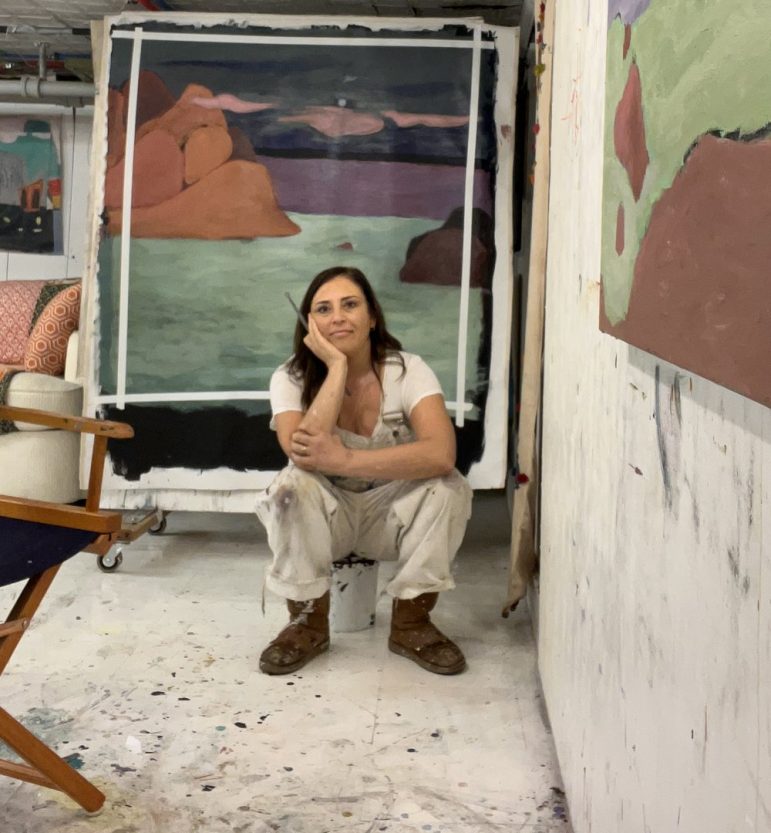
Jocelyn Fine
Division of Arts & Culture (DAC): Tell us about how this show came together.
Jocelyn Fine: The concept for this show was conceived by Sandra. She was away overseas at a residency last summer and noticed work that I had been posting on social media. She saw an immediate relationship between our work and contacted me as soon as she got back to talk about her experience and her new work. There was a lot of synergy between our art, and it was interesting that we were both grappling with the same subject matter; this reverence for landscape; places we had been and places we dreamed of someday going. At some point she asked if I would be interested in having a show with her, and I loved the idea.
Sandra Charlap: I was away at a residency in France and in my down time was scrolling through IG. I’ve been following Jocelyn’s work for years; however, I began to feel a synergy between us that I hadn’t noticed before. Because I was so deep into my work and exploring the narrative of wanderlust and identity, I felt this great pull towards her paintings. I knew once I returned, I needed to reach out and connect with her about this. The idea for doing a show came quickly and we were grateful that 1978 has chosen us to represent the town during Women’s History month.
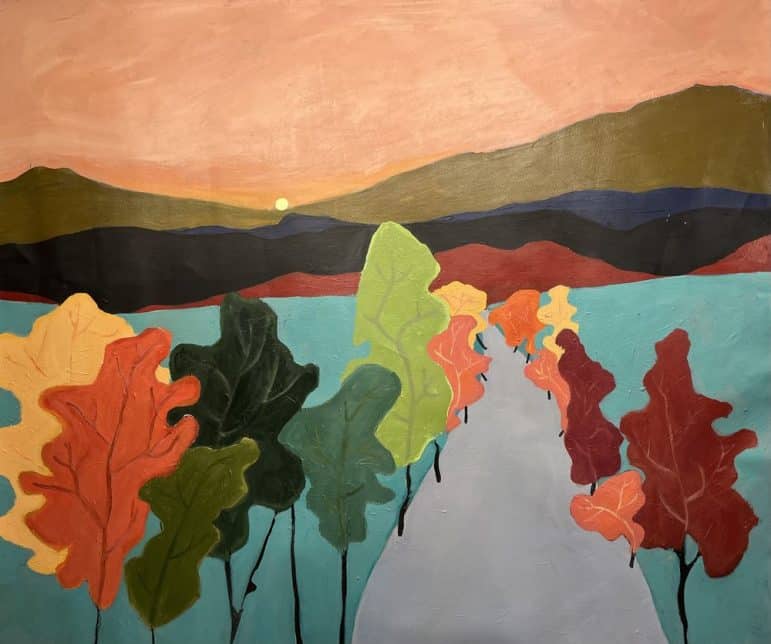
When the Trees Bow. Jocelyn Fine.
DAC: What would you like to highlight about how the viewer takes in the conversation between your two different artistic styles?
SC: I think the relationships we both have with color and form, though different, are a unique language that serves to define how we view landscapes. There is a feeling of space in Jocelyn’s paintings that is well juxtaposed to the density of my cities and landscapes. Color is another aspect that unifies our work, in fact, I think it very defining; Setting the tone for time of day and place, it brings the viewer into the image.
JF: I totally agree, I am a visual person and art is fundamentally how I communicate. I think Sandra would agree that we best communicate through mark making. Our styles are totally different and reflect who we are as people, and artists; our marks are different, and our compositions are different, but we both are “talking” about landscape and our environment. As both artists and friends, we thought it would be interesting to think of the show in terms of us communicating with each through working paint.
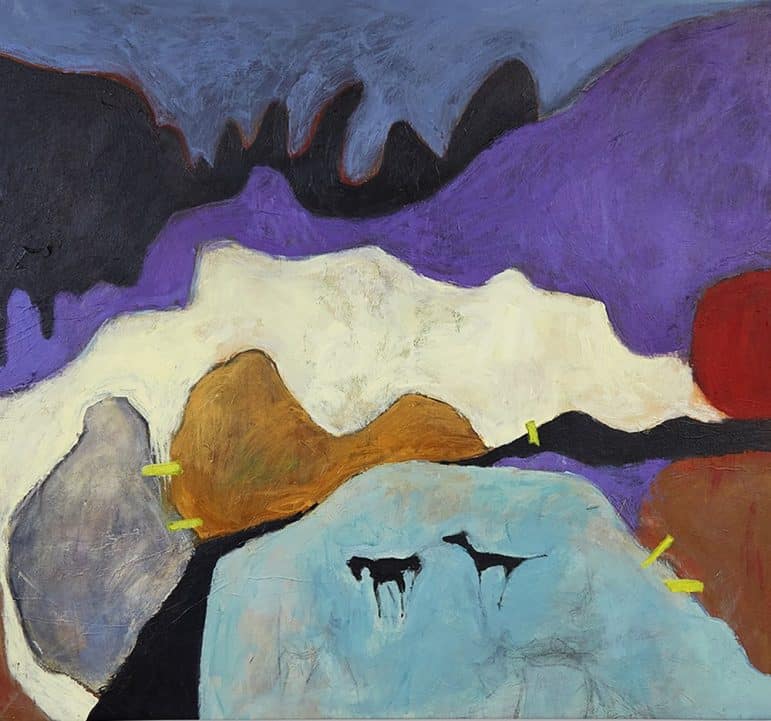
End of the Earth. Jocelyn Fine.
DAC: As breast cancer survivors, how has your work changed or grown since your diagnosis? Has your creative process changed?
JF: Breast Cancer had a huge impact on my art. I had been working full time, commuting into the city every day, with 2 young kids at home, living this incredibly chaotic life, when I got the diagnosis. Suddenly everything came to halt; everything just stopped. I would sit on the front porch and just stare at the trees for hours. My world got really small, but I found comfort in doing the things that brought me joy. I always had art in my life, but I started to find a daily practice; something I hadn’t had time for in years. I could escape through my art, and it provided me with a sense of purpose. I had a lot of reservations about working with oils and solvents, so I decided to work exclusively with acrylic water-based paints. More than anything, I think my diagnosis forced me to reevaluate how I wanted to live my life and what I wanted to do. I could no longer ignore all those things that I had pushed off and said, “I’ll get to that later.” Painting art became a priority and I have made it part of my daily practice ever since. I escape through my art, and it has afforded me an opportunity to revisit memories from my past. My landscapes are largely based on childhood memories of traveling through the US and Europe in a blue chevy van with my 3 siblings and my parents. My goal was to access all those visual memories that reside deep in my consciousness. I know from hearing Sandra talk about her art, that her exploration of place and landscape is also deep rooted in this idea of ‘anything is possible’. While I was thinking about the past, and the places I had seen, she was fixated on the future and all the places she would dream of going.

Sandra Charlap
SC: Breast cancer, as Jocelyn so eloquently describes, puts an immediate halt to life as I knew it. There would now be a “before” and an “after”. During the ensuing months of surgeries, chemo and doctor’s visits there wasn’t anything left in me (or so I thought) to create. Though my art practice was lying dormant, my creative mind was hard at work. Once I emerged and regained my strength, I began creating art in earnest, and I have not looked back since.
DAC: What are your priorities as an artist and how does your work reflect these priorities?
SC: My priorities as an artist is to stay in consistent practice and to dive deeply into my subject matter and narrative. I’ve had times in my career that I’ve explored subjects and materials in quick succession, however, for the past 18 months I’ve been staying on the subject of destination as a way of exploring this time and place in my life: What is home? Where is home? Is there a place for me? These are questions I pose to myself as well as the viewer when presenting my paintings. Some paintings are fully aerial as I’m still exploring those cities, and some are more definable as I get to know a place more intimately. The main priority is for me to stay focused and allow this story to unfold.
JF: Consistent practice is critical, and I always make being in the studio regularly a priority. Even if I’m not painting, I’m mixing colors, sketching, looking at books, or just being in my space. Like Sandra said you must be present and let the story unfold. It’s there, but it’s not always so easy to access. You must be present and be ready for it when it comes.
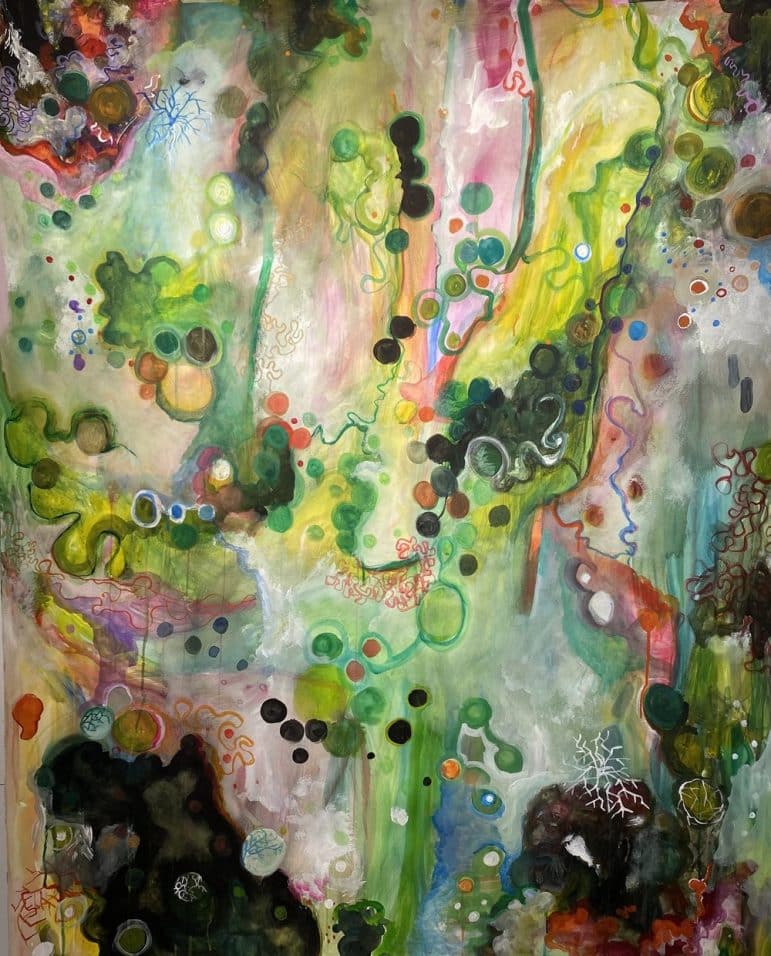
Crafters, S.A.- Mt. Lofty Botanical Gardens, Australia. Sandra Charlap.
DAC: Where do you draw inspiration? Who are the artists that influence your work?
JF: My art is heavily influenced by the New York School of abstract expressionists of the 1940’s and 50’s. My great Aunt was the owner of the eponymous Rose Fried Gallery on Manhattan’s Upper East Side, and I have grown up surrounded by art from that period. I especially love Estaban Vicente—his color palette is extraordinary, and Richard Diebenkorn, Milton Avery and Philip Guston, Helen Frankenthaler, and Matisse. I also draw a lot of inspiration from my family. My mother is a sculptor, my brother a painter, my other brother is a film maker, and my sister manages an art fund – both my kids are in art school. I feel so lucky to have so many artists in my life and so much of their work influences me. Teaching has also been a source of growth and inspiration for my own work. Art is intimate and expressive; children understand that intuitively.
SC: I draw inspiration from so many sources. I am very inspired by the artist Nick Cave; His work is profound and beautiful, utilizing a wide range of materials that are wholly unexpected. My work is often translated in different materials as well. When I’m exploring themes, I’m curious to see how it might further the narrative in another medium. Rackstraw Downs is also another influence. His work is beautifully rendered landscapes of unexpected places. Elevating areas that are often overlooked and presenting them in such a carefully attended way is incredibly beautiful. Art to me has the power to shift perspectives and allow the viewer to see the world in new and refreshed ways.
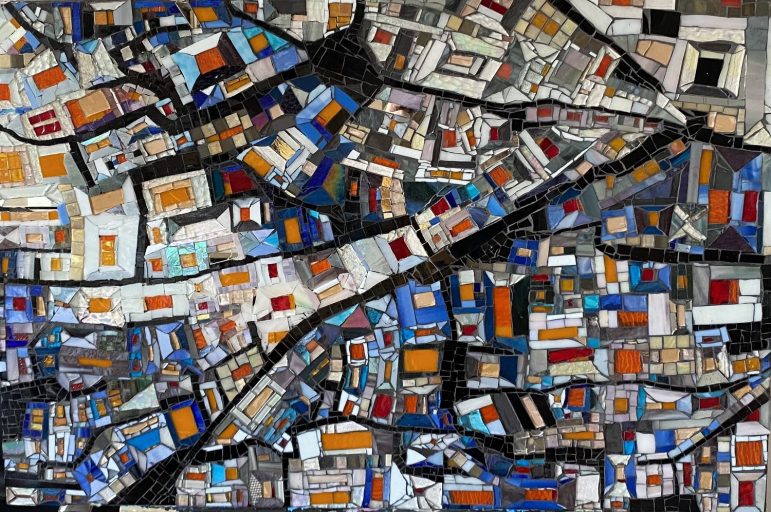
The Magic Hour. Sandra Charlap.
DAC: Who/what are some of the local people, places or organizations/businesses that help support you as an artist? Here’s your opportunity for a local shout out.
SC: I feel so supported in our community. I’ve been a part of Soma for 26 years and have, over time, developed many meaningful relationships both personally and professionally. I have worked with Jespy House in South Orange for the past few years and the community there is vibrant and creative. I’ve also begun teaching a wide variety of classes that cross all ages for the Maplewood Rec dept. They have been immensely supportive of my ideas and ambitions, and I am having a great time teaching in our community. There are so many incredible programs and opportunities for this supportive arts community and it’s exciting to be at the forefront of it.
JF: Also, the Maplewood Village Alliance has created a variety of opportunities for artists to periodically showcase their work. Over the years, I have participated in the Art Walk, and The Studio Tour, and this month my art will be featured at the Maplewood Mercantile for the Windows for Women Month.
DAC: What do you hope to see in terms of support for artists in Maplewood/SOMA/NJ in the future? What resources could be added or improved to aid in this support?
JF: One of the things that originally attracted me to the community was the appreciation for the arts. I loved that my kids could experience such high-quality art programs, and the art educators at CHS were outstanding. For a community with as many artists as there are, I guess it’s a little surprising that there is no one art community. There are also very few places to exhibit work. I know the town has tried to find ways to share the artists’ work with the community, but it would be amazing to see a gallery space in both towns. I think that collectively, having a Mapso artist community could be so powerful. I think there is a lot that an organized community of artists can do to foster and encourage art. Some ideas would be monthly panel discussions for aspiring artists, mentoring opportunities, workshops, and artist residencies.
DAC: As working artists, what are your biggest challenges?
SC: As a working artist my greatest challenge is time. I hate saying no to an opportunity and will find myself packing in a lot of things. But, there’s absolutely nothing I love to do more than to make art, be challenged with new commissions, and to pass on my knowledge to those interested in learning.
JF: When we are not in our studios, both Sandra and are teaching art. I teach and chair the art department at Montclair Kimberley Academy, and my time in the studio often starts at 4:00 in the afternoon. I’m very protective of my weekends, and rarely make plans to do anything other than paint. Also worth noting is that both of my kids are in college (both art schools), so there is no one counting on me for rides and dinners. I’m pretty sure Sandra would agree that having grown kids make our art schedules more manageable now than they were years ago. Keeping a daily practice, and fulfilling my teaching responsibilities can be very challenging, but being in the classroom with my students is also very inspiring and incredibly rewarding.

